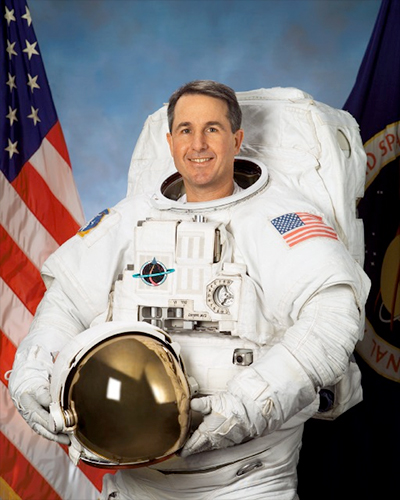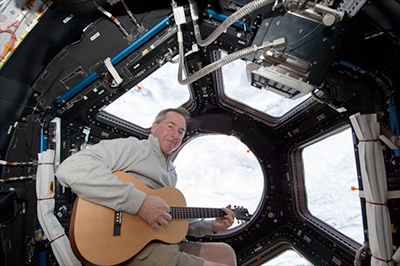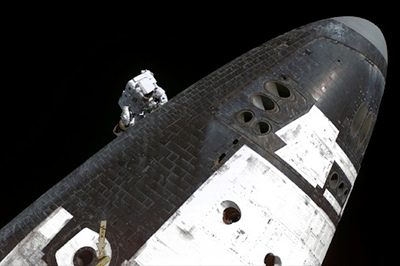Astronaut Stephen Robinson, a veteran of four space shuttle missions, is hanging up his spacesuit and returning to the University California, Davis, this fall as a professor in the College of Engineering's Department of Mechanical and Aerospace Engineering. Robinson, who earned his bachelor's degree in mechanical and aeronautical engineering from UC Davis, will lead a new center conducting research on human-vehicle interaction.
"Dr. Robinson brings a wealth of experience as he returns to UC Davis," said College of Engineering Dean Enrique J. Lavernia. "We're honored to have him join us, and not merely because of his high profile as an astronaut. He was winning awards as an outstanding engineer long before he ever went into space. Steve will be a great addition to our distinguished faculty, and we know he'll be a primary contributor to the increased focus on 'space' by the Department of Mechanical and Aerospace Engineering."

Robinson officially retired from NASA on June 30 and will take up his duties at UC Davis as fall quarter begins on Sept. 24.
"After almost 40 years of considering myself a Cal Aggie, it is time to come back and contribute to the place that gave me such a great start," Robinson said. "Besides the pull of home territory, UC Davis offers a unique academic combination of expertise in aerospace engineering, psychology and neuroscience to serve as a basis for new kinds of aerospace research."
Robinson will take the lead in establishing the Center for Human-Vehicle Integration and Performance at UC Davis, intended to be a center of expertise for machine-enhanced human performance in hazardous environments, such as atmospheric flight, spaceflight, and robotic surgery.
The center will aim to integrate the university's strengths in neuroscience, cognitive psychology and aerospace engineering to develop human/hardware/software systems that radically extend human capability in these high-stakes environments, Robinson said.
Robinson said he's especially excited for the opportunity to teach UC Davis students. During spring quarter 2013, he will teach a new class that he said he wishes had been available when he was an undergraduate: "Introduction to Spacecraft."
"I'm certain the one who does the most learning will be me," he said.
In his career at NASA, Robinson logged more than 1,156 hours and 19.8 million miles in space, including more than 20 hours of "extra-vehicular activity" or spacewalks. He has flown on four space shuttle missions: on the shuttle Discovery, in 1997, 1998 and 2005; and in February 2010 on the shuttle Endeavor.
Robinson's second Discovery mission was made alongside John Glenn, who famously returned to space 36 years after he became the first American in orbit on Feb. 20, 1962, aboard the Friendship 7 Mercury capsule.
Robinson's third flight, in 2005, was the first shuttle mission to the International Space Station after the loss of the Columbia. Robinson served as flight engineer on that mission and made three spacewalks totaling more than 20 hours, including an unprecedented repair of the shuttle's heat shield.
As a boy growing up in Northern California, Robinson says he was crazy about flying machines. By age 14, he was building and flying hang gliders in his back yard.
After surviving those attempts and graduating from Campolindo High School in Moraga, Calif., Robinson enrolled at UC Davis, where he studied mechanical and aeronautical engineering -- and built more of his own flying machines. He was also a DJ at KDVS, the campus's student-run radio station.
Robinson graduated in 1978 with a double major in mechanical and aeronautical engineering. By that point, he already had spent three years at the Ames Research Center in Moffett Field, Calif. through NASA's Cooperative Experience Program. He joined the staff at Ames in 1979 as a research scientist in the fields of fluid dynamics, aerodynamics, experimental instrumentation and computational scientific visualization.
In 1981, Robinson submitted the first of several applications for NASA's astronaut program. While at Ames, Robinson earned his master's degree (1985) and doctorate (1990) from Stanford University, with research emphases in turbulence physics and human eye dynamics. He also founded and operated an engineering and graphics software firm in Mountain View, Calif., from 1982 to 1986.
In 1990, Robinson was selected to become chief of the Experimental Flow Physics Branch at NASA's Langley Research Center in Virginia. Three years later, he was awarded the NASA/Space Club Low Memorial Engineering Fellowship, and assigned to MIT as a visiting engineer in the Man Vehicle Laboratory. He returned in September 1994 to NASA's Langley facility, where he accepted a dual assignment as a research scientist in the Multidisciplinary Design Optimization Branch and leader of the Aerodynamics and Acoustics element of NASA's General Aviation Technology program.
He was selected as an astronaut in 1994 and entered the astronaut training program at Johnson Space Center in 1995. Since then, Robinson has held numerous technical assignments within the Astronaut Office: testing shuttle control software, developing on-board computer and flight crew equipment, leading various aerodynamic studies, and leading an astronaut team to specify window requirements for the Orion crew capsule. Aside from his own four missions aboard Discovery and Endeavor, Robinson served as spacecraft communicator at Mission Control for 17 other missions. Most recently, he spent two years as chief of safety for the Astronaut Office and a year as director of the NASA JSC Virtual Reality Laboratory.
In 2005, Robinson was presented with the UC Davis Medal by then-Chancellor Larry Vanderhoef. Robinson also sponsors an annual UC Davis scholarship fund for engineering students in financial need.
Robinson enjoys flying, antique aircraft, kayaking, hiking, drawing, painting and stereo photography. He plays lead guitar in the all-astronaut rock 'n' roll band Max-Q, and also plays the bass, banjo, mandolin, pedal-steel guitar and cello.














